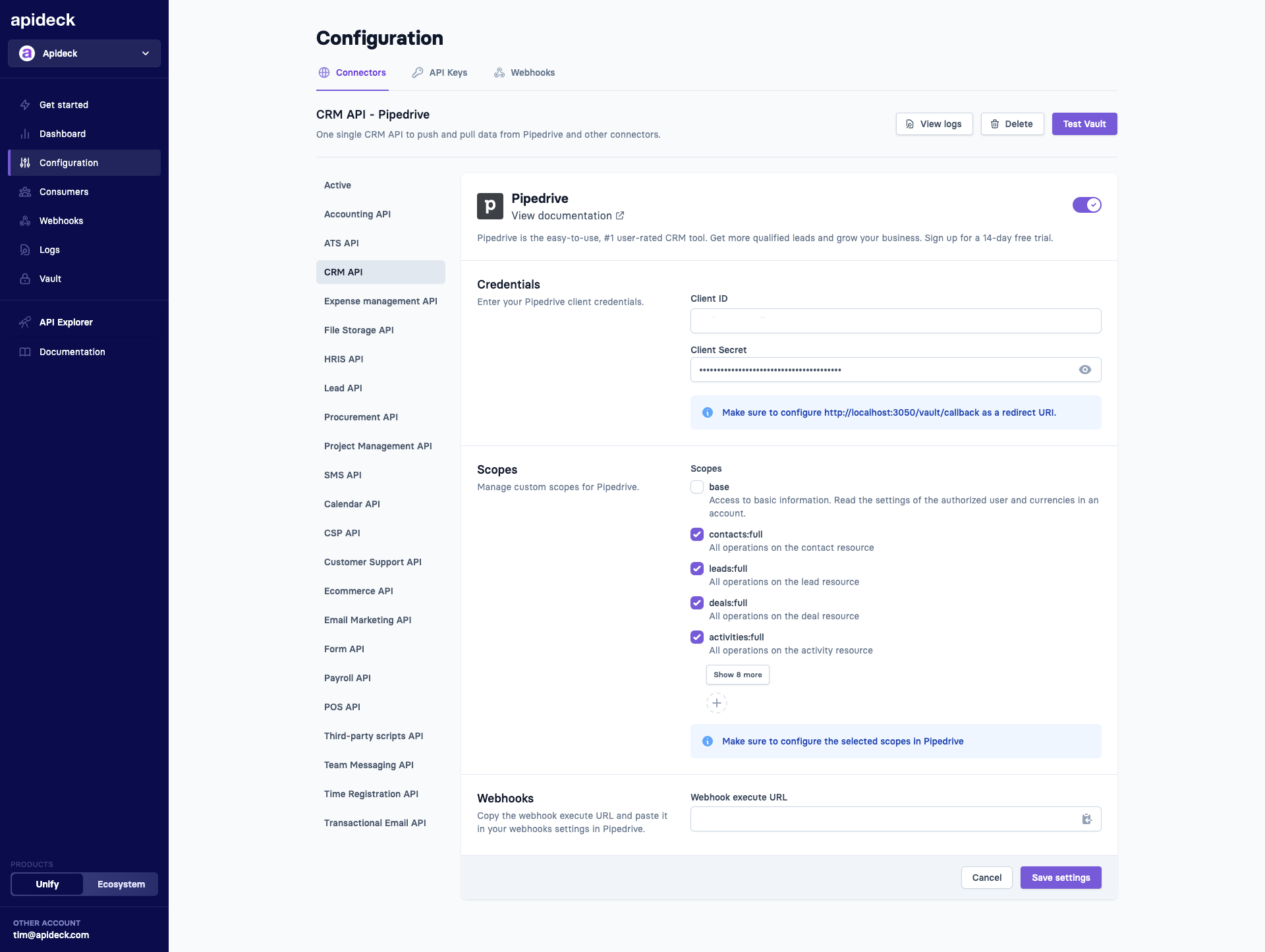Pipedrive guide for OAuth app & webhook registration
Pipedrive is a powerful CRM tool that helps you to manage your sales pipeline. With the Pipedrive connector, you can easily connect your Pipedrive account to Apideck and automate your workflows. The following guides will help you to set up the Pipedrive connector in Apideck:
- Pipedrive Oauth Guide: this guide will help you to register your OAuth application in Pipedrive.
- Pipedrive Webhooks Guide: learn how to set up webhooks to receive real-time Unify webhook events from Pipedrive updates and changes.
Pipedrive OAuth App Registration
Create your OAuth app
Go to the Pipedrive Portal (https://app.pipedrive.com/auth/login) and sign in with your Pipedrive account.
After you are logged in, go to the "Marketplace" > "Marketplace manager"

In the Marketplace overview click the Create new app button to create a new OAuth app.
Select your app type
Select the type of App you want to create and click the Next button.

Public apps are apps that are available to all Pipedrive users. Private apps are only available to the users that you add to the app.
Basic information
Fill out basic information about your OAuth app.
 Enter the name and description for your app, and fill in the fields you find relevant or necessary.
Enter the name and description for your app, and fill in the fields you find relevant or necessary.
When users authenticate your app with their Pipedrive account, they'll see the name, description, logo, and any support contact info you provide on this page.
OAuth Access scope settings
In the app details, you will see a section called "OAuth & Access scopes" where you can configure the OAuth settings for your app.

-
Verify if the Oauth scopes, match the scopes needed for you to access the Pipedrive API. If you need to add or remove scopes, you can do so by toggling the buttons.
-
Set the Redirect URI for your app. This is the URL where users will be redirected after they authenticate your app with their Pipedrive account.
-
Enter
https://unify.apideck.com/vault/callbackas Redirect URI for your app. This is the URL where users will be redirected after they authenticate your app with their Pipedrive account. -
If you want your app to be installed from the Pipedrive Marketplace, you'll need to:
-
Create an endpoint in your application that will:
- Accept the OAuth callback from Pipedrive
- Generate a state parameter using Apideck's createCallbackState API
- Forward the request to
https://unify.apideck.com/vault/callbackwith: - The
codeparameter received from Pipedrive - The generated
stateparameter
Example Node.js implementation:
-
Configure this endpoint URL in Pipedrive:
- Use your callback URL (e.g.
https://your-domain.com/oauth/pipedrive/callback) as the Redirect URI - Make sure your domain is accessible via HTTPS
- Test the OAuth flow thoroughly before submitting to the marketplace
- Use your callback URL (e.g.
-
-
If you are finished, click "Save", which will store all your preferences & App settings. After you have saved your application settings, the Client ID and Client Secret will be generated. You will need these credentials to connect your Pipedrive account to Apideck.

💡 TIP: Copy the Client ID and the Client secret and save them in a secure place. You will need them in the next step.
More details on the configuration of an OAuth Pipedrive app can be found in the online help of Pipedrive.
Vault Connection Setup
Goto the Apideck > Configuration > CRM > Pipedrive

Enter the OAuth client ID & Secret from Pipedrive and review if the scopes granted in Pipedrive match with the scopes you are requesting in Apideck. Press "Save settings" to save your credentials.
You can test the connection by clicking "Test Vault", which will check if the connection is working.
Now you are ready and clients can authorize the connection to their Pipedrive account in a secure way.
Pipedrive Webhook Registration
Register a Pipedrive webhook in Unify
Go to the Apideck > Configuration > CRM > Pipedrive On the Unify Pipedrive connector settings, at the bottom, you can find the "Webhook Execute URL"

💡 IMPORTANT: Copy the full "Webhook execute URL" since you need this URL to register it in Pipedrive
Create a webhook subscription in Pipedrive
To register a webhook using the Pipedrive Portal, follow these steps:
-
Sign in to your Pipedrive account and go to the "Settings" menu.
-
In the "Settings" menu, click on the "Webhooks" submenu.

- On the "Webhooks" page, click on the "New Webhook" button.

-
In the "Create New Webhook" modal, enter the URL of the webhook and select the events that the webhook should be triggered for from the drop-down menu. As "Endpoint URL", you should enter the "Webhook execute URL" from Unify (see above steps)
-
Click on the "Save" button to register the webhook.
After the webhook has been registered, you can view and manage it from the "Webhooks" page in the Pipedrive settings. You can edit the webhook settings, test the webhook, or delete the webhook as needed.
Subscribe to Unify events
After you have completed the above steps, you can subscribe your application to Unify Events.

The following guide will explain all the steps to subscribe to Unify webhooks events: How to subscribe to webhook events